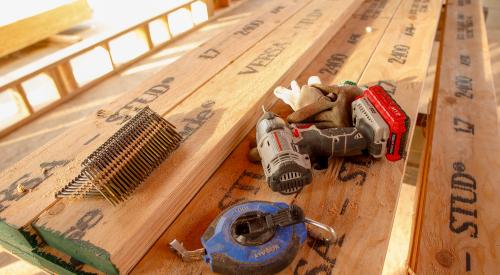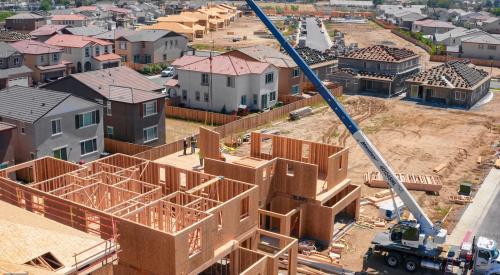| "With steel, we’re getting design innovations we could never achieve with wood." -- Brookfield Homes president Jeff Prostor.
|
Brookfield Homes president Jeff Prostor sees big trouble brewing in Southern California’s construction labor market, and he’s a little uneasy about lumber supply and prices. Fortunately, he’s steeling his Orange County home building operation against both.
All puns aside, Prostor and Brookfield vice president of design and development Adrian Foley are national leaders in the use of steel framing. And they’re also setting benchmarks in trade contractor relations that builders across the country can follow to become the employer of choice in tightening labor markets.
The Orange County incarnation is one of nine Brookfield home building entities scattered across the continent from South Florida to San Diego to Calgary, Alberta. All are owned by Brookfield Properties, a Toronto-based real estate conglomerate that, among $4 billion in assets, has 40 million square feet of class A office buildings in New York, Chicago, Denver, Minneapolis and elsewhere.
A decentralized, highly entrepreneurial corporate structure allows Prostor to operate with remarkable autonomy. He uses the freedom to stay on the cutting edge in design and marketing as well as trade relations and use of alternative materials. To his credit, Prostor keeps the innovation focused on the bottom line as well as the top, which shows 400 homes delivered for $160 million in revenue, a tidy contribution to Brookfield’s $715 million in home building revenue. That lands Brookfield at No. 20 in this year’s Giants rankings, up from 27th a year ago.
However, it is the Orange County firm’s trade relations and use of steel framing that builders elsewhere should think about emulating.
"I have no doubt that we’re going to face a real crisis in construction trades, especially framers, sometime soon," Prostor says. "Construction work is now just about last among job preferences for kids coming out of high school. The unions that once did all the training for us are no longer a factor. Already, we see a marked decline in the number of foremen on job sites. And it’s going to get worse."
Prostor and Foley developed an interest in steel framing when they were running the Southern California division of Taylor Woodrow Homes 10 years ago. Price spikes in framing lumber were the motivation then, and that possibility still exists. What they learned about steel from doing small, experimental projects is to avoid thinking of it as a commodity to replace wood studs on a stick-by-stick basis. "We rely on the existing infrastructure of framers and labor yards," Prostor says. "But that’s where the sameness ends.
"Steel can do a lot of things wood can’t. We learned to educate our architects and engineers on all those capabilities, so they take advantage of them in their designs. For example, you can vary the gauges of steel between load-bearing and non-load-bearing walls. You can do spans with steel that would be impossible with wood. At one project, we used 10-inch-wide steel studs to create deeper architectural relief on window insets. To do that with wood, you’d have to double-frame everything," says Prostor.
Look at Brookfield’s designs, and it’s easy to see that the company is building some of the most intricate, architecturally exciting product on the West Coast. "We’re getting design innovations we could never achieve in wood," Prostor says.
Brookfield also uses the obvious advantages of steel over wood in structural strength, fire resistance and termite resistance to market homes. "When we educate people on these issues, the feedback we get is always a preference for steel," Prostor says.
Today, Brookfield is one of the largest users of steel framing on the West Coast. Many of the firm’s projects are done entirely in steel because architecturally they would not be feasible any other way.
On the labor front, Brookfield is a leader in creating efficiencies in field operations that allow pieceworking trade crews to make more money on their jobs. "That’s the bottom line," Foley says. "If the job site is more efficient, work can be done faster. We make better margins. But the trade contractors and even individual workers also make more money. That’s what it takes to be the employer of choice in a tight labor market. More productivity is better for both sides. We are partners in the search for efficiency, not adversaries."
Brookfield and trade relations consultant Steve McGee employs "job ready/job complete" survey forms, which are filled out every day by every trade. They create a record of the condition of the job site for each trade when the crew arrives and leaves. That allows all the trades to work as an integrated team rather than get in each other’s way or accidentally compromise the time of the next trade on site.
"We have a responsibility to act as a catalyst, to bring the concepts of self-measurement and continuous improvement to the trades," Foley says. "It’s amazing how little measurement goes on in these firms. Most of them don’t know which builders’ jobs are most profitable for them to work on. We want them to know."
Prostor and Foley both spend six days per month on job sites, working with the trades to convince them that measurement is a tool for self-improvement, not a club the builder will use to beat them down on price.
Also See Movers and Shakers:
Lennar Redefines Bigness
Spectrum Skanska Hits Highest Price Point
Regis Homes Ups Ante on Quality
Morrison Leads the Charge to TND
Newmark Has New Model for Growth in Roaring 2000s
Estridge Pioneers "First Mile"
Crossman: Quiet but Profitable
ALH: Private Acquisitor Rising











